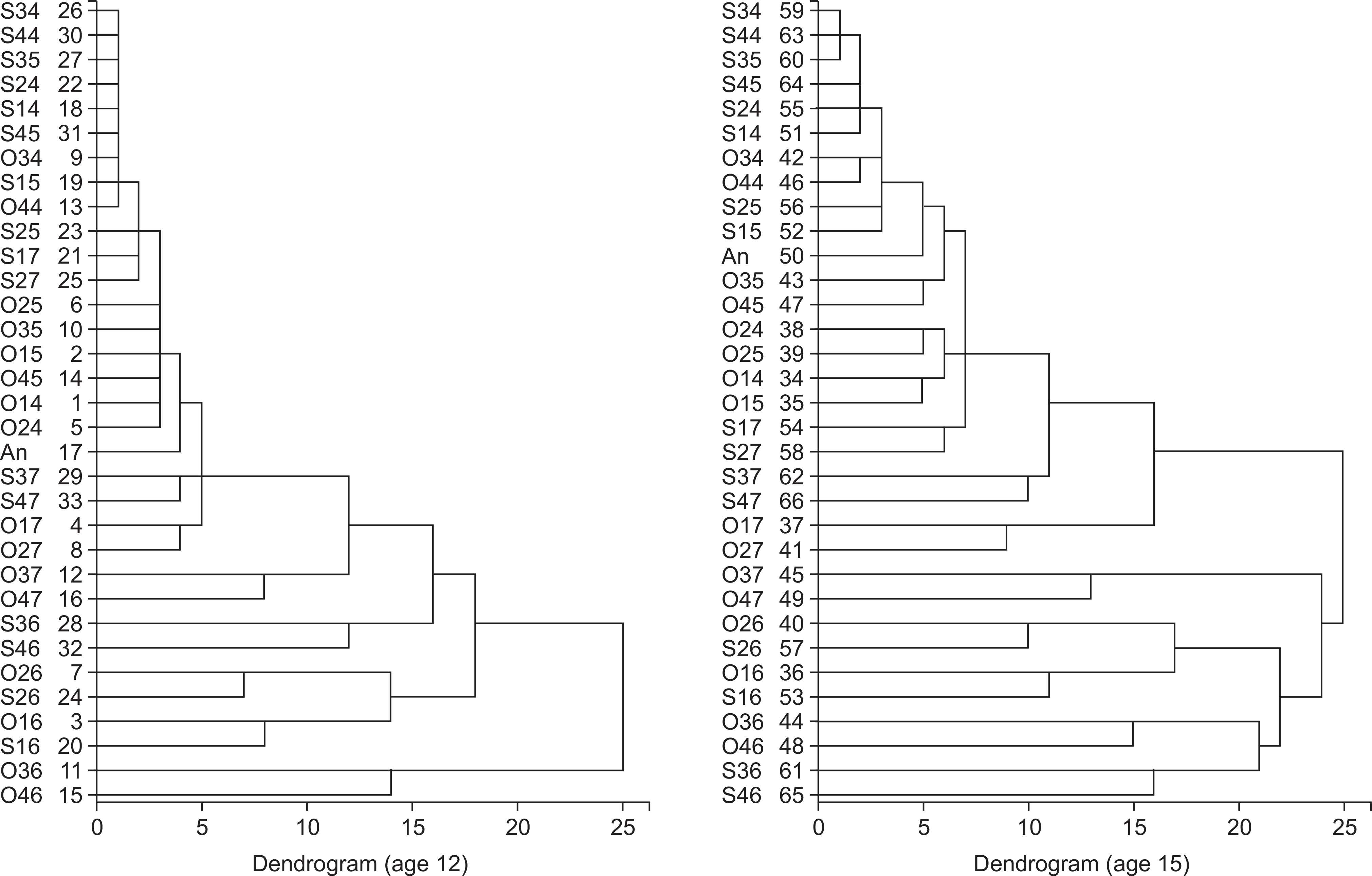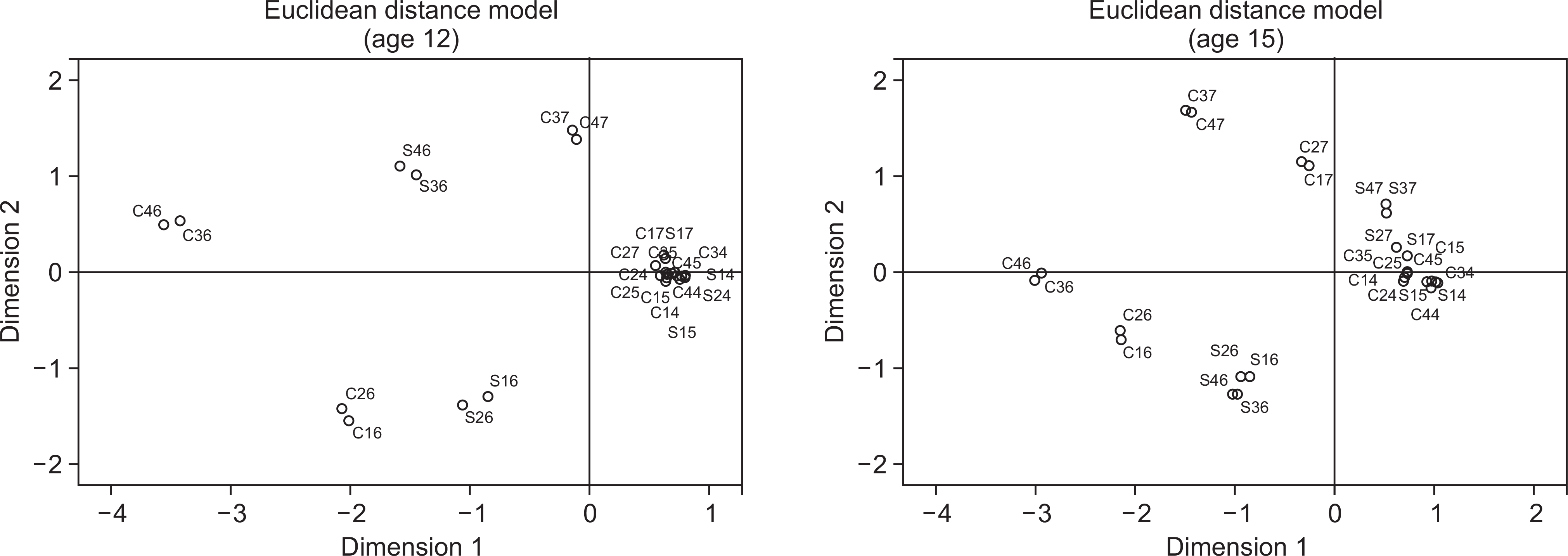Abstract
Objectives
The purpose of this study was to analyze the patterns of dental caries experience on the tooth surface of Korean adolescents of the ages of 12 and 15 years.
Methods
The raw data from the 2012 Korean National Oral Health Survey were reviewed, and the records of a total of 10,542 adolescents were analyzed in this study. The surfaces of the 28 permanent teeth were categorized into the occlusal, smooth, and proximal surface types. Descriptive statistics, correlation analysis, multidimensional scaling analysis, and cluster analysis were performed to analyze the data.
Results
The analysis of the relationship of the dental caries experience on the tooth surfaces between the oral quadrants revealed that the correlation between the surface relationship of the left and right teeth was higher than that between the upper and lower teeth, in all of the quadrants. As a result of multidimensional scling analysis, the adolescents aged 12 were classified into six clusters: occlusal surface of mandibular first molars, occlusal surface of maxillary first molars, smooth surface of maxillary first molars, smooth surface of mandibular first molars, occlusal surface of mandibular second molars and the rest of tooth surface. Similarly, the dental surfaces of the 15-year-old adolescents were classified into seven clusters: occlusal surface of the mandibular first molars, occlusal surface of the maxillary first molars, smooth surface of the first molars, occlusal surface of the mandibular second molars, occlusal surface of the maxillary second molars, smooth surface of the mandibular second molars, and the surfaces of the. The patterns of caries experience are usually clustered on the same types of tooth surfaces; for example, patterns on an occlusal surface clustered with those on another occlusal surface, or patterns on a smooth surface with those on another smooth surface.
Go to : 
References
1. Kaste LM, Selwitz RH, Oldakowski RJ, Brunelle JA, Winn DM, Brown LJ. Coronal caries in the primary and permanent dentition of children and adolescents 1-17 years of age: United States, 1988-1991. J Dent Res. 1996; 75:631–641.

2. Batchelor PA, Sheiham A. Grouping of tooth surfaces by susceptibility to caries: a study in 5-16 year-old children. BMC Oral Health. 2004; 4:2.

3. Lee JS, Lee KH, Kim DE. Caries patterns in primary dentition by caries experience of individual teeth. J Korean Acad Pediatr Dent. 1999; 26:1–13.
4. Psoter WJ, Zhang H, Pendrys DG, Morse DE, Mayne ST. Classification of dental caries patterns in the primary dentition: a multidimensional scaling analysis. Community Dent Oral Epidemiol. 2003; 31:231–238.

5. Psoter WJ, Pendrys DG, Morse DE, Zhang HP, Mayne ST. Caries patterns in the primary dentition: cluster analysis of a sample of 5169 Arizona children 5-59 months of age. Int J Oral Sci. 2009; 1:189–195.

6. Jeong SY, Lee KH, Ra JY, An SY, Kim YH. Dental caries patterns in the primary dentition: a cluster analysis and a multidimensional scaling analysis. J Korean Acad Pediatr Dent. 2010; 37:159–167.
7. Shaffer JR, Feingold E, Wang X, Tcuenco KT, Weeks DE, DeSensi RS, et al. Heritable patterns of tooth decay in the permanent dentition: principal components and factor analyses. BMC Oral Health. 2012; 12:7.

8. Shaffer JR, Feingold E, Wang X, Weeks DE, Weyant RJ, Crout R, et al. Clustering tooth surfaces into biologically informative caries outcomes. J Dent Res. 2013; 92:32–37.

9. Lee BG, Lee HS, Ju HJ, Oh HW. Dental caries pattern in primary dentition among Korean children. J Korea Acad Oral Health. 2014; 38:95–104.

10. Jung SH, Ju HJ, Lee HS. Dental caries experience pattern in perma- nent dentition among Korean adolescents. J Korea Acad Oral Health. 2015; 39:134–144.
11. Vanobbergen J, Lesaffre E, García-Zattera MJ, Jara A, Martens L, Declerck D. Caries patterns in primary dentition in 3-, 5- and 7-year-old children: spatial correlation and preventive consequences. Caries Research. 2007; 41:16–25.

12. Lee KH, Ra JY, An SY, Kim YH. Degree of symmetry of dental caries in primary dentition. J Korean Acad Pediatr Dent. 2010; 37:453–460.
13. Burnside G, Pine CM, Williamson PR. Modelling the bilateral symmetry of caries incidence. Caries Research. 2008; 42:291–296.

14. Ministry of Health and Welfare. Korean national oral health survey 2012. Seoul: Ministry of Health and Welfare;2012.
15. Lee YH, Kwon HK, Kim BI. The dental caries experience of Korean in 2000 by tooth and surface type. J Korea Acad Oral Health. 2004; 28:315–323.
16. Jin BH, Moon HS, Paik DI, Kim JB. A study on the models predicting 6 - year - old children’s DMFS increment in one year. J Korea Acad Oral Health. 1992; 16:429–451.
17. Hopcraft MS, Morgan MV. Pattern of dental caries experience on tooth surfaces in an adult population. Community Dent Oral Epidemiol. 2006; 34:174–183.

18. Kutesa A, Mwanika A, Wandera M. Pattern of dental caries in Mu-lago Dental School clinic, Uganda. Afr Health Sci. 2005; 5:65–68.
19. Armfield JM, Spencer AJ. Community effectiveness of fissure sealants and the effect of fluoridated water consumption. Community Dent Health. 2007; 24:4–11.
20. Ahn SH, You HY, Kim MJ, Han DH, Kim JB, Jeong SH. Caries preventive effect of permanent teeth using pit and fissure sealant program and community water fluoridation program. J Korea Acad Oral Health. 2012; 36:289–296.

21. Kim YK, Roh BD, Min JB, Park SH, Park JK, Park JW, et al. Operative dentistry : Tooth conservation & restoration. 3rd edition. Seoul: Shinhung international;2010. p. 100–124.
22. Lee HS, Lim JH. SPSS 20.0 manual. Seoul: Jyphyunjae;2013. p. 446–498.
23. Park JS, Lee HO, Jang YH, Ji MK, Ji YJ. Oral microbiology. Seoul: Komoonsa;2014. p. 247–256.
24. Gisselsson H, Birkhed D, Björn AL. Effect of a 3-year professional flossing program with chlorhexidine gel on approximal caries and cost of treatment in preschool children. Caries Res. 1994; 28:394–399.

25. Gisselsson H, Birkhed D, Emilson CG. Effect of professional flossing with NaF or SnF2 gel on approximal caries in 13-16-year-old schoolchildren. Acta Odontol Scand. 1999; 57:121–125.
Go to : 
 | Fig. 2.Cluster analysis (age 12, 15). O: Occlusal, S: Smooth surface, An: Anterior smooth surface. |
Table 1.
DMF rate by age unit: %
Table 2.
Correlation of DMFS indexs among the quadrant in permanent dentition
| Side | Age 12 | Age 15 | |
|---|---|---|---|
| Upper · Lower | Total | 0.458* | 0.432* |
| Occulsal | 0.546* | 0.555* | |
| Smooth surface | 0.456* | 0.432* | |
| Proximal | 0.268* | 0.341* | |
| Right · Left | Total | 0.613* | 0.590* |
| Occulsal | 0.673* | 0.676* | |
| Smooth surface | 0.612* | 0.590* | |
| Proximal | 0.418* | 0.468* | |
| Upper right · Upper left | Total | 0.649* | 0.663* |
| Occulsal | 0.645* | 0.656* | |
| Smooth surface | 0.559* | 0.573* | |
| Proximal | 0.390* | 0.418* | |
| Upper right · Lower right | Total | 0.509* | 0.528* |
| Occulsal | 0.514* | 0.543* | |
| Smooth surface | 0.381* | 0.374* | |
| Proximal | 0.183* | 0.243* | |
| Upper right · Lower left | Total | 0.491* | 0.507* |
| Occulsal | 0.493* | 0.519* | |
| Smooth surface | 0.369* | 0.364* | |
| Proximal | 0.166* | 0.243* | |
| Upper left · Lower right | Total | 0.501* | 0.537* |
| Occulsal | 0.511* | 0.548* | |
| Smooth surface | 0.392* | 0.392* | |
| Proximal | 0.222* | 0.275* | |
| Upper left · Lower left | Total | 0.530* | 0.547* |
| Occulsal | 0.536* | 0.548* | |
| Smooth surface | 0.414* | 0.396* | |
| Proximal | 0.216* | 0.264* | |
| Lower right · Lower left | Total | 0.658* | 0.673* |
| Occulsal | 0.660* | 0.681* | |
| Smooth surface | 0.541* | 0.528* | |
| Proximal | 0.294* | 0.344* |
Table 3.
Correlation of each tooth surface by age




 PDF
PDF ePub
ePub Citation
Citation Print
Print



 XML Download
XML Download